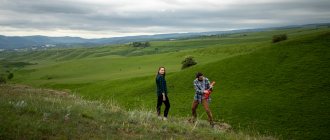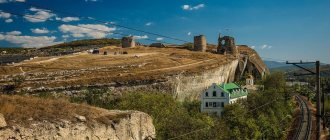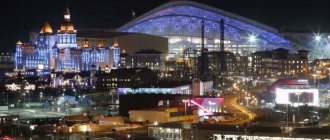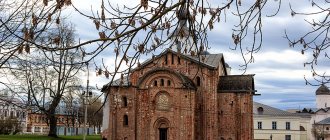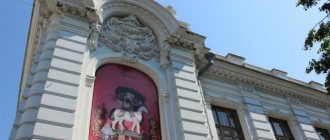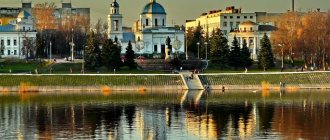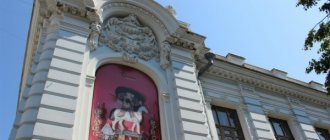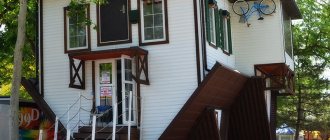This article talks about interesting places, beaches and attractions of Balaklava and its surroundings. What to see, where to go in Balaklava.
Balaklava (Crimea) is a beautiful place in the southwest of the peninsula, which is often called the “Crimean Venice”. A charming town, steeped in legends and mysteries, located on the quaint shores of Balaklava Bay, which can be seen in numerous photographs. Some people associate the word “balaclava” with the mask worn by robbers. But it does not mean “mask”, but “fish bag” - Turkish origin.
Until 1957 it was a separate settlement, and then became a suburb of Sevastopol. The map shows that Balaklava is separated from it by 15 kilometers. You can arrive from any Crimean city by car or public transport. For those wishing to visit Balaklava, there are several ways. You can arrive by bus "Sevastopol - Balaklava" or by car. You can get there from Simferopol - 78 km, if you follow the highway, you need to cover 63 km in a straight line. The distance from Alushta to Balaklava is 108 km, and if you drive in a straight line by car, it is only 67 km.
TOP 4 - what to visit in the vicinity of Balaklava
Due to the specifics of its location, Balaklava is a worthy competitor to Sevastopol. Its unique bay and surrounding terrain have attracted sailors since the times of the ancient Greeks. But even with such a large anthropogenic load, there are still interesting places in the vicinity of the city that allow you to take a break from civilization.
Balaklava Bay
- Coordinates on the map: 44.496768, 33.597883.
Balaklava stands on the shore of its own Black Sea bay. Balaklava Bay is distinguished by its small width, but great depth and length (1.5 km), with a complex winding shape. As a result, it turns out to be an ideal harbor, protecting from bad weather and allowing ships to hide from unwanted eyes.
It is believed that she was first mentioned in the Odyssey. It is a fact that since the Middle Ages Balaklava Bay has been used as a base for warships. And the USSR installed a submarine repair plant in it. Now the bay is not used militarily, but is open for peaceful navigation. There are beaches on its shores.
Cape Aya
- GPS coordinates: 44.417896, 33.671716.
A long rocky ridge, according to some geographers, is one of the boundaries of the Sevastopol Bay. The territory of the cape is a natural reserve, but anyone who follows environmental rules can visit it. You only need to pay if you want to stay on site overnight (for camping).
Cape Aya is interesting for its unusual species and significant biodiversity - there are many rare plants, and dolphins are often found off the coast. The coast of the cape is intricately indented; in the resulting coves there are wild beaches popular with tourists. Thanks to the protected regime, the water is clean. There are underwater grottoes in the area of the cape, which attracts divers.
Wall of Ushakov
- Coordinates: 44.441658, 33.643438.
It can only be viewed from the sea (many excursion boats depart from the embankment). The Ushakov Wall is a completely sheer rock mass between Balaklava and Cape Aya. There is no beach in this place. But in the sea at the foot of the cliff, dolphins are often observed.
The name arose from the legend that the array was used by Admiral Ushakov as a target when training naval gunners. The fact cannot be proven, but the admiral loved to come up with original methods for training his subordinates, so he would have done with it.
Kadykovsky quarry
- Coordinates: 44.516670, 33.568541.
This is an artificial formation that has long become natural. The Kadykovsky quarry was formed as a result of the work of the mining complex and gradually filled with water. Now it is a full-fledged lake, on the shores of which a lot of small animals live.
The quarry is officially considered the lowest point of Crimea - it is located 14 m below sea level. It’s not easy to get down to the water along its banks, but the scenery around is excellent, and even in Crimea sometimes you want to swim in fresh water.
Rock Mytilino
- Coordinates: 44.491322, 33.585173.
On the western shores of Balaklava, the Mytilino rock rises - a beautiful and extremely picturesque place where it is worth going or swimming. It is important to remember that you need to climb to the very top of the rock carefully - it is dangerous, especially for unprepared individuals. Equipment, shoes and clothing must be appropriate.
How to get to the village
It is located 15 km from Sevastopol and is an autonomous settlement that is part of the Balaklava region. The large flow of tourists required the establishment of regular transport links, so you can get here in several ways:
- From Sevastopol - from the bus station, at short intervals there are regular bus No. 17 and minibuses No. 17, 20, 26. You need to get to the final stop and transfer to a vehicle that will take you to the center or the Submarine Museum.
- A more convenient way is to call a taxi. The cost of the trip will be approximately 800-860 rubles, but they will deliver you directly to the place without transfers.
- By personal transport you need to drive through the ferry crossing, then the P-29 highway will lead to Balaklava.
- From Moscow and other Russian cities it is easier to fly to Simferopol, and from there get there by taxi or public transport.
Where you can go for a walk in Balaklava
For quite a long time, Balaklava was a closed city, not intended for idle pastime. Therefore, there are few entertainment options here. However, now the city has turned into a tourist center, and the situation is gradually changing. The only thing is that there are still few recreation areas for children - Balaklava is still an “adult” city.
Nazukina embankment
- Address: emb. Nazukina.
The central city embankment is named after the revolutionary sailor, but there is nothing revolutionary in its architecture. The appearance of the embankment was created by the joint efforts of ancient and Mediterranean styles. It has recently been qualitatively renovated.
This is the center of local social life, as is always the case in resort towns. There are many interesting restaurants and prestigious local hotels on the embankment. During the season, street artists and musicians focus on it. There is also a yacht club here - a spectacle that is interesting not only to the rich.
Tavricheskaya embankment
- Address: emb. Tauride.
The second city embankment occupies the western part of the bay coast. Until 2007, it did not have the status of an embankment, being part of an ordinary city street.
Therefore, Tavricheskaya gives way to the Nazukina embankment as the center of Balaklava social life. It is quieter and calmer here, with less entertainment and amenities, but there are several pleasant restaurants and good, but relatively inexpensive hotels.
On the Tavricheskaya embankment there is an entrance to the underground museum-factory; the Yusupovs’ house also stands here. From here you can also admire the yachts of the yacht club (their berths are located near both embankments).
Mount St. Elijah
- Coordinates: 44.510417, 33.602868.
In addition to the embankments, in Balaklava it is worth taking a walk to the top of Mount St. Elias, located in fact within the city. It is not high, the climb is accessible to everyone, even children and the elderly, but the views from here are memorable - the bay and the surrounding area will be at your fingertips.
Mount Tavros
- Coordinates: 44.500554, 33.591966.
While walking around Balaklava, you can climb this hilly hill, however, to learn about its past, it is better to use the services of a guide. The view of Balaklava Bay from here is also simply wonderful.
Balaklava red mullet
Red mullet in Balaklava is the same as smelt in St. Petersburg. Not just fish, food or even a living. This is a kind of symbol, a tourist hook and the true love of the locals. The red mullet is found not only in Balaklava and not only in the Black Sea, but in this bay it doesn’t care if it’s covered in honey.
Baked red mullet is a symbol of Balaclava
A small fish, no more than 15 cm long, surprisingly not bony, the meat is easily separated. And the taste is beyond words!
In general, visiting Balaklava and not trying red mullet (it can be lightly smoked in bulk or grilled in a restaurant) is a big miss. Since the fish is tiny, its normal portion is up to 10 pieces. You can try Balaklava red mullet at the Fisherman's Hut or the Balaklava restaurant. They cook it deliciously at Barkas, but this is in Artbukhta.
By the way, in Crimea it is considered cool to have a proven “drummer”. It's like having your own butcher or hairdresser. And it is not cheap - from 500 rubles. per kg.
Historical monuments of the city of Balaklava
Despite its modest size, the city has “inherited” a lot in history. Photos of the sights of Balaklava decorate all tourist brochures dedicated to Crimea. A visit here is especially recommended for fans of military history - they will definitely find something to do here.
Chembalo Fortress
- Coordinates: 44.494588, 33.598760.
The remains of a fortified castle, built in 1343 by Genoese colonists, are located above the city on Mount Castron. Chembalo has been the scene of violent conflicts throughout its history. The Genoese competed for it with the Tatars and Theodorites, and the last time the fortifications were used for their intended purpose was already during the Great Patriotic War.
In comparison with the Sudak fortress, the Balaklava fortress was preserved rather poorly and has not been restored. However, there is still something to see there, especially since the ancient towers have not been “tweaked” by restorers. Also from the foot of Chembalo there are wonderful views of the city and Balaklava Bay.
Chorgun Tower
- Address: st. Mezhgornaya, Chernorechye village.
This medieval building is located quite far from Balaklava, but only from this city can it be reached by public transport. The Chorgun Tower is a single structure (not part of a large fortress).
The official version of its purpose is to provide protection to the local population in the event of an attack. The tower was not intended for permanent residence (although there are living quarters there).
The origin of the tower is still controversial - it is either Theodorite or Genoese. The most popular assumption is that it was built by a certain Turkish Pasha. Russian soldiers defended it during both defenses of Sevastopol, and the medieval structure successfully withstood the new weapons.
Balaklava Valley
- Coordinates: 44.528357, 33.612211.
This is the site of a famous battle during the Crimean War, which became the “grave of the British cavalry”. Even before the end of hostilities, the British (who occupied Balaklava at that time) built a cemetery in the valley for their dead.
The peace treaty obliged Russia to treat the graves of enemy soldiers with respect, and it complied with this requirement. In 1945, W. Churchill visited the British cemetery near Balaklava.
On the occasion of the 50th anniversary of the First Defense, a monument to the Russian participants in the battle was erected near Balaklava (now there is another one, because the first one was destroyed during the Great Patriotic War). In 1994, a memorial for the reconciliation of the parties involved in the Crimean War was erected there (the former opponents actually made peace a long time ago).
Archaeological research in the Balaklava Valley is carried out by British and French archaeologists. There are also reenactor festivals there.
Balaklava forts
- Coordinates: 44.493054, 33.619818 (South); 44.503909, 33.607366 (Northern).
There are two of them - South and North. They were laid down by the occupying British troops during the Crimean War, but Russian military engineers then decided not to let the good go to waste.
From two forts, the valley between Balaklava and Sevastopol was clearly visible and shot through, which provided an additional opportunity to defend the city of Russian sailors from land.
The successful location of the fortifications allowed Soviet soldiers to successfully use them in 1944 during the decisive battle for Sevastopol. Today, the North Fort is a popular site for historical reenactors.
Barrel of Death
- Coordinates on the map: 44.493063, 33.619841.
This is an unusual military facility built before the First World War. It impresses with its simplicity and practicality.
The observation post room is made of good steel and is fixed in a concrete base. It has the shape of a half-cylinder (the open part is directed towards the base and serves as an entrance), so that the observer is provided with excellent visibility.
The walls do not reach the base - there is a grate there, into which you can stick the barrel of something firearm and fire at the enemy approaching from below.
The “Barrel of Death” survived two wars, in both of them it was used for its intended purpose, and is still in good condition.
19th battery
- GPS coordinates: 44.492597, 33.590141.
This attraction is not a museum object, but anyone can visit it (with some caution). The coastal battery was built before the First World War and was intended to protect Balaklava Bay.
But it became famous in the Second Defense, when the garrison under the command of Captain Mark Drapushko fired at ground targets from it. Battery No. 19 even withstood the fire of Hitler’s giant Karl mortars.
After the collapse of the USSR, the battery was mothballed and then written off. Her weapons were sold for scrap. Now enthusiastic reenactors are trying to put it in order and create a museum and educational complex on its basis.
Object 100
- Coordinates: 44.494052, 33.638678.
The facility is abandoned; average tourists are not invited here. It is a military shelter in case of nuclear war and a cruise missile base. It once had several launchers and even carried out tests simulating a nuclear attack.
After the collapse of the USSR, the missiles and launchers disappeared into obscurity, and all other “stuffing” of the base was stolen by looters.
All that remains are concrete rooms, on the walls of which the pragmatic inscriptions of the military are supplemented by a huge amount of “stalker” graffiti. Some excursion bureaus organize trips here on ATVs for this category.
Barrel of Death
Address: Mount Asceta
The barrel of death is an iron structure in the shape of a semicircle with loopholes on both sides; it is located above an abyss. Its height is 2 meters and its diameter is 1.7 meters. This barrel was part of the “South Fort”, which was built during the First World War. Initially there were two such barrels, but one of them was either cut off or knocked down during hostilities.
There were rumors that the barrels were used not as a fortification element, but as a place for executions. They say that during the German occupation, captured sailors were shot in barrels and their bodies were thrown into the abyss. This is evidenced by bullet holes at head level. In addition, confirmation of this version was published in the 60s. in the magazine "Ogonyok".
Now the barrel of death is a kind of memorial and a place with a beautiful view of the open sea. Some extreme sports enthusiasts like to climb onto the outer front of the barrel and hang from it.
The most interesting museums of Balaklava
There are few museums in the city, but one of them is absolutely unique, and the second is simply good. Reviews from museum lovers about Balaklava are invariably enthusiastic.
Balaklava Museum Underwater Complex
- Address: st. Tanker Revkova, 4.
This is the most famous tourist site in Balaklava. Its creation was associated with a program to protect the country in the event of a nuclear war. The conditions of Balaklava made it possible not to fear tectonic shifts during a hypothetical atomic bombing. And the depth of the bay allowed large submarines of that time to pass through it. The construction of the facility turned Balaklava into a closed city in 1962.
Now it is a museum and at the same time the world's largest declassified military facility. You can only get into the museum with a guided tour, and children under 5 years old are not allowed into it at all. There are various excursion programs, including boat trips through underground tunnels. Due to the high humidity and underground location, the site is quite cold - you should take warm clothing with you.
Read: Excursions in Balaklava
Museum of the History of Balaklava
- Address: emb. Admiral Klokachev, 5.
The museum has a general name, but a rather narrow specialization - it talks mainly about the events of the Crimean War. The exhibition features many original and reconstructed items from that era, telling about all sides of the conflict. Although the museum is intended for an adult audience, many children will also be interested in it.
The museum has recently started operating and is still in its formation stage. He also constantly organizes temporary exhibitions of artistic and historical material of various directions. You can find out about such exhibitions either from the museum announcements (it is located on the Nazukin embankment, so the posters are visible) or by telephone.
Chembalo Fortress
Ruins of the citadel
In the 14th-15th centuries, Balaklava was a Genoese colony. It was during this period that one of the most famous historical attractions of the resort was built - the Chembalo fortress. A citadel with eight towers and a castle inside was built on Mount Kastron. On the slopes there was a settlement, which was surrounded by walls with six towers.
At various periods, Russian and Turkish military garrisons were located in the Cembalo fortress. The buildings were seriously damaged during the Crimean and Great Patriotic Wars. Only a few structures have survived to this day.
Why does the city have this name?
According to one version, the bizarre name of the city has Turkish roots and is translated as “fish bag” or “fish nest.”
Along a well-trodden path you can climb to the top of the mountain, where the upper city once stood. All that remains of many buildings are ruins. Among the few buildings of the citadel that have survived to this day, we highlight a twenty-meter tower (donjon). We recommend, in addition to visiting the ruins of the ancient fortress, to enjoy the views from the heights of the mountain. Below are the remains of ancient buildings of the lower city, which can also be viewed.
City landmarks and monuments
There are few monuments in the usual sense in Balaklava, but they do exist. Surprisingly, military monuments do not predominate among them.
Monument to A.I. Kuprin
- Address: Nazukina embankment.
The writer lived and worked in the city before and during the first Russian revolution. He reflected his impressions in an essay.
Since Kuprin was not enthusiastic about the revolution, during Soviet times there was no monument to him in Balaklava (although his work was not banned in the USSR). The decision to install the monument was made in 2005 and implemented in 2009. at the same time, it was not the most original project that was selected (there was, for example, a proposal to seat a bronze writer at a restaurant table).
As a result, Kuprin (without a pedestal, in natural size) simply stands at the embankment fence and looks at the sea.
Monument to Lesya Ukrainka
- Address: Kalicha street.
The Ukrainian poetess visited Balaklava (she, suffering from tuberculosis, was shown the Crimean climate). She came to the city once as a child, the second time as an adult. In this regard, the city decided to erect a monument to her. This was done in 2004.
The monument is a half-figure on a high column-shaped pedestal. Local experts on legends say that the sculptor was initially ordered to create a bust of the poetess, but during the process of work he went crazy and made a little more.
Monument to Submariners
- Address: Mramornaya street.
The monument was erected back in 1975, but now in Balaklava there is a copy from 2016. The fact is that after the collapse of the USSR, the Ukrainian authorities for some reason decided to dismantle the monument.
There is a significant difference between a copy and an original. Outwardly, they look the same - there is a stone obelisk on a small platform, and next to it is a fragment of a submarine's cabin.
However, in the original monument it was part of a real “baby” type boat. In 2016, it turned out to be impossible to find another similar fragment, so the “cabinet” for the monument was made anew.
Beaches
The city has four beaches where tourists can have a good rest, sunbathe, and engage in active sports.
Yashmovy Beach
Jasper is popular in Crimea. The beach is covered with multi-colored pebbles: red, green, bluish-gray, brownish, black. It stretches for 450 m. The entrance to the water is not very steep. The infrastructure is well developed: sun canopies, a first-aid post, a toilet, places for changing clothes, trash cans, a kiosk with souvenirs, tents with ice cream and soft drinks. You can rent sun loungers and vehicles for boating.
Vasili Beach
Located near Cape Fiolent. The width is 30-40 m, the length is small - about 300 m. The beach area is well equipped: toilets, changing rooms, rescue service, sun canopies, sun loungers. The entrance is gentle and very comfortable.
Beaches Golden and Silver
Not so long ago they were wild, but now they have become popular among holidaymakers. They now have minimal infrastructure: a rescue post, equipment rental, dry closets.
Shaitan Beach
A small beach with a length of approximately 20 m and a width of about 10. When there is a storm at sea, the beach area is drowned, so it is not possible to stay on Shaitanka for a long time.
You may be interested: 10 best beaches in Koktebel.
The best churches, temples and cathedrals of Balaklava
Although Crimea demonstrates a great diversity of cultures and religions, Balaklava is more homogeneous in this regard. The Christian population has long dominated here, and local religious monuments belong to the Orthodox Church.
St. George's Monastery
- Address: Path of Health, Fiolent.
The monastery, located on Cape Fiolent, is interesting for its antiquity. Legends claim that it was founded in the 9th century (when those shipwrecked in this place seemed to be helped by the saint to whom they turned).
Reliable sources indicate a slightly shorter, but still respectable period - the 13th-14th centuries. In addition to above-ground ones, the monastery also has cave structures.
The monastery is currently active, so it is not possible to explore it completely. However, you can admire the buildings from the outside (most of them date back to the 18th century) and go into the church. There is a park near the monastery where there is a good observation deck with binoculars.
On topic: Sights of Fiolent
Temple of the Twelve Apostles
- Address: st. Kuprina, 15A.
The building was built in 1794 on the site of an old Genoese church (by that time destroyed). After the Crimean War, it needed reconstruction, so now you can see the version from 1875.
The church is interesting for its unusual combination of styles. The cross-domed design, characteristic of Orthodoxy, is combined with purely antique pagan Doric columns.
Batiliman tract
How to get there:
- From Sevastopol: at the bus station, take the bus to Yalta and get off at the “Laspi” stop. From the stop go down to Laspi Bay.
- Take the Yalta highway to Laspi Bay (drive about 40 km).
The Batiliman tract is a coastline running along the rocks and surrounded by forest. The name is translated from Greek as “deep harbor”.
This place is ideal for relaxation. There is fresh air, clean sea and beautiful scenery. People of creative professions love to come to the tract for inspiration.
If you want to take beautiful shots or just admire the terrain and views, be sure to climb the Kush-Kaya rock (altitude about 650 meters).
Many plants on the territory of the tract are listed in the Red Book. Particularly significant and valuable are the different species of juniper, which make the air healing. Therefore, people suffering from diseases of the respiratory, nervous, and cardiovascular systems, as well as children, should visit the tract for health purposes.
Where to go in Balaclava for architecture lovers
There are a lot of simply interesting buildings in Balaklava - interesting in purpose, style or other indicators. The only drawback of this group of Balaklava monuments is that their condition is far from ideal; the old buildings have long been in need of restoration.
Chorgun Aqueduct
- Coordinates: 44.542051, 33.663819.
The water supply bridge looks exactly like its ancient Roman counterparts. But it was built by the English engineer J. Upton on the instructions of the famous admiral M.P. Lazarev in the middle of the 19th century.
The aqueduct supplied water to the freshwater docks of Sevastopol, where the wooden bottoms of sailing ships were freed from the dangerous grinder. Even now the aqueduct fulfills its duties to some extent. It supplies water to gardening communities.
Hunting lodge of the Yusupov princes
- Address: Mramornaya street.
The richest Russian family had many properties in Crimea. The princely family managed to build a small (according to their standards) house in Balaklava, but did not live in it - the revolution got in the way.
It is not clear why it is called a “hunting house” - the house is located at the end of the embankment, and it is most likely to go fishing there. The house has never been restored, it is empty and is not an excursion site (yet). But its architecture is original and impressive even in its current “damaged” form.
Mikhaili House
- Address: emb. Nazukina, 41/2.
The recently restored house in the Art Nouveau style that was fashionable at the beginning of the 20th century belonged to the mayor. In addition to architectural features. It is interesting because Lesya Ukrainka lived in it during her second visit to Balaklava.
Until recently, the building was in disrepair, and only in 2022 was its major renovation completed.
Of course, the modern materials used have somewhat spoiled the color, but now you can approach Mikhaili’s house along the embankment, and it does not threaten tourists with falling on their heads. The main features of Art Nouveau architecture were preserved during the restoration.
Wrangel Mansion
- Address: st. Kalicha, 19.
It belonged not to the baron, whom the Red Army knocked out of Crimea in 1920, but to the chief architect of Sevastopol (also a nobleman). M.A. Wrangel supervised the development of Sevastopol in the 20-30s of the last century. He was also the author of the design of his own house - quite simple, albeit spacious.
The mansion is now an ordinary residential building with small private “enterprises” on the ground floor. But it belongs to the state as a historical monument and is not subject to privatization.
Dacha of engineer A.M. Zavadsky "Fata Morgana"
- Address: Tavricheskaya embankment, 22.
Tourists who want to take memorable photos are sure to visit this place - a historical value near the Tavricheskaya embankment. But today it has definitely lost some of the graceful details, shapes and elements that it had under Zavadsky.
Church of the Twelve Apostles
Address: Rubtsova street, 41
The Church of the Twelve Apostles is a small functioning temple in the center of Balaklava. Historians suggest that the temple was founded back in 1357 near the Chembalo fortress. This theory is confirmed by writings left on a stone that was found during the restoration of the church. The inscription says that construction began under the Genoese consul Semono de Orto.
It is unknown to whom the temple was originally dedicated. Following the Crimean War, it was called the Church of St. Nicholas.
As a result of hostilities, the temple was destroyed; only fragments of the foundation were preserved, which served as the basis for restoration work (carried out in the 18th century). During Soviet times, the church premises were given to the House of Pioneers. After the collapse of the USSR, the building again acquired its religious significance; the temple was dedicated to the 12 apostles.
If you have not yet chosen where you will live and want to save money when booking, we recommend using the RoomGuru service. Firstly, it contains hotels, apartments and guest houses from many different booking systems, so you won’t miss out on a worthwhile option. Secondly, you can immediately compare prices for one place in different services and book where it is cheaper (this is not always Booking!).
Other interesting places in Balaklava
And in Balaklava there are places that do not fit into the “thematic blocks”, but simply offer an interesting pastime and a good rest. Fans of good alcohol and increased levels of adrenaline in the blood will enjoy life in this Crimean city.
"Golden Beam"
- Address: st. Krestovsky, 66.
This is a famous agricultural company engaged in growing grapes and producing wine. Initially it was created as one of the wine farms of Prince Lev Golitsyn, who was the founder of a significant part of the Crimean industrial winemaking.
The plant holds various educational and promotional events for those interested. It also hosts a regular wine festival. The official website reports on the planned events; the activities of Zolotaya Balka are also actively covered by the media.
19th gun battery
Surviving parts of the military installation
The 19th gun battery was installed at Cape Couron at the beginning of the twentieth century. Its main purpose was to protect the approaches to Sevastopol from the sea.
The guns that were located here were capable of hitting targets at distances of up to twenty kilometers.
Outbuildings and barracks were located not far from the battery. The military used the defensive line during the battles of the Great Patriotic War, and at the end of the twentieth century the battery was dismantled as much as possible.
Currently, all that remains of the 19th gun battery is a concrete platform with traces of the guns located on it. Travelers who come here to see the traces of the military installation with their own eyes can enjoy excellent sea views.
FAQ
What are the must-see attractions of Balaklava?
First of all, we recommend taking a walk along the city embankment, where there are many historical and cultural attractions.
St. George's Rock
Marble cross on a rock
An unusual name is given to a mountainous island located near Cape Fiolent. According to local legend, the Greek sailors who became the founders of the St. George Monastery saw St. George on the rock (it was to him that they owed their miraculous salvation).
- In the 19th century, a marble pedestal with an Orthodox cross was built on the island (it was removed in the twenties of the last century).
- At the end of the twentieth century, a metal analogue was installed in place of the removed cross, but a few years after the storm it fell.
- At the beginning of the twenty-first century, an eight-meter marble cross mounted on a granite slab appeared above the island.
Travelers get to St. George's Rock by boat, and some swimmers swim here on their own. From the top of the cliff you can admire the sea views, as well as the St. George Monastery, located on the shore.
FAQ
Is Balaclava suitable for a beach holiday?
There are several beaches in the Balaklava resort and its surroundings.
Fedyukhin Heights Park
Friends, don’t miss this fascinating historical living history park in the neighboring village of Pervomaiskoye. It will be of interest not only to fans of the history of the Crimean War, but also to children and inquisitive adults.
There are several themed areas to visit:
- Roman fort of the 1st-3rd centuries - a theater for gladiator fights
- Genoese manor of the 15th century - a piece of medieval life
- Crimean War - several sites, redoubts, fortifications
Entrance to the territory without a tour is free. A ticket is required to visit thematic exhibitions. Themed entertainment takes place during the season.
- You can get from Balaklava by bus No. 8 or taxi, because the distance is only 8 km.
- Official website: feduhpark.ru
Kadykovsky quarry
The peculiarity of the quarry is the water of an unusual color.
The Kadykovsky quarry is located in the northwest of the resort of Balaklava. It was used by a local mining operation (it is gradually being abandoned). Over the course of several years, the artificial reservoir became a small lake.
The main feature of this quarry is the water of an unusual rich blue color. Travelers try to visit the Kadykovsky quarry (Lake Heart) to conduct a photo shoot.
We do not recommend going down to the lake, as there is a high risk of landslides.
Sevastopol trail
part of the trail
the Sevastopol Trail, a large mountain route that also passes through the outskirts of Balaklava. The total length of the route is one hundred kilometers. There are infrastructure elements for travelers along the entire route, so the Sevastopol Trail is accessible to both professionals and amateurs.
There are several options for walking along the Sevastopol trail.
Tourists do not have to cover the entire route, but choose a small section for themselves (tourists can select a route based on complexity, duration, and comfort on the project website).
Throughout the entire journey along the Sevastopol trail, picturesque mountain landscapes open before travelers.
St. George's Monastery
Location of the monastery
The oldest religious center of Crimea is located not far from the picturesque Cape Fiolent.
According to legend, the St. George Monastery was founded in the ninth century by Greek sailors. Their ship was caught in a storm, but thanks to prayers to St. George the Victorious, the ship did not crash on the rocks. As gratitude for the miraculous rescue by the sailors, a monastery was founded on the shore.
For several centuries, the monastery remained an active religious site, despite numerous wars and other historical events. The monks left the holy monastery for some time, but at the end of the twentieth century the monastery was restored.
The St. George Monastery is primarily of interest to pilgrims, as it preserves many architectural monuments:
- late nineteenth century chapel;
- cave temple of the late 19th century;
- the source of St. George (restored in the twenty-first century);
- the main building of the monastery, which is a reconstruction of a temple from the 9th to 14th centuries.
Not far from the monastery complex there is a park for walking (the park has a rotunda gazebo and convenient viewing platforms).
